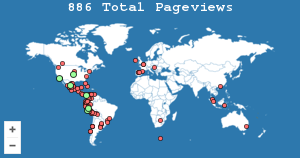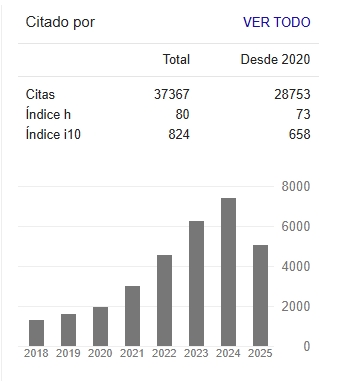Análisis integral de categorías teóricas en la inclusión financiera: una revisión sistemática
Abstract
La disponibilidad de servicios financieros es vital para reducir la pobreza, impulsar la economía y estimular el crecimiento económico. El presente estudio tiene como objetivo analizar la inclusión financiera a través de una revisión sistemática. Para ello se utilizó el método (PRISMA), evaluando 70 artículos de Elsevier en doce categorías, tales como desarrollo financiero inclusivo, impacto ambiental, desarrollo sostenible, pobreza, estabilidad financiera, desarrollo económico, regulación, demografía, educación, responsabilidad social, tecnología financiera y construcción de índices de inclusión financiera. Los resultados de la literatura subrayan que, durante la pandemia de COVID-19 y eventos económicos recientes como la crisis energética de 2022 y la inflación global postpandemia, tecnologías como el dinero móvil y los cajeros automáticos facilitaron el acceso a servicios financieros, amortiguando los efectos económicos adversos, especialmente para los más vulnerables. Se concluye que las políticas proactivas y la educación financiera son esenciales para el crecimiento sostenible. La inclusión financiera no solo favorece el desarrollo económico, sino que también ayuda a reducir la pobreza y la desigualdad, además de contribuir a la mitigación del cambio climático mediante la reducción de emisiones de carbono.
References
Ahamed, M., & Mallick, S. (2017). Is financial inclusion good for bank stability? International evidence. Journal of Economic Behavior & Organization 157(54), 403–427. https://doi.org/10.1016/j.jebo.2017.07.027
Ajefu, J., Demir, A., & Haghpanahan, H. (2020). The impact of financial inclusion on mental health. SSM - Population Health, 11(10). 1-10 https://doi.org/10.1016/j.ssmph.2020.100630.
Akande, J., Hosu, Y., Kabiti, H., Ndhleve, S., & Garidzirai, R. (2023). Financial literacy and inclusion for rural agrarian change and sustainable livelihood in the Eastern Cape, South Africa. Heliyon, 9 (6), 1-12. https://doi.org/10.1016/j.heliyon.2023.e16330.
Alam Iqbal, B., & Sami, S. (2017). Role of banks in financial inclusion in India. Contaduria y Administracion, 62(2) 644-656. https://doi.org/10.1016/j.cya.2017.01.007.
Allen, F., Demirguc-Kunt, A., Klapper, L., & Peria M. (2016). The foundations of financial inclusion: Understanding ownership and useof formal accounts. Journal of Financial Intermediation , 27, 1-30. https://doi.org/10.1016/j.jfi.2015.12.003.
Álvarez-Gamboa, J., Cabrera-Barona, P., & Jácome-Estrella, H. (2021). Financial inclusion and multidimensional poverty in Ecuador: A spatial approach. World Development Perspectives, 22, 100311. https://doi.org/10.1016/j.wdp.2021.100311.
Angga, E., Dwi Riyanto, F., & Masakazu, S. (2020). Financial inclusion, economic growth, and poverty alleviation: evidence from eastern Indonesia. Heliyon, 6(10), 1-13. https://doi.org/10.1016/j.heliyon.2020.e05235.
Arun, T., & Kamath, R. (2015). Financial inclusion: Policies and practices. IIMB Management Review, 27(4), 267-287. https://doi.org/10.1016/j.iimb.2015.09.004.
Basu, S. (2016). India emerging: New financial architecture. IIMB Management Review, 28(3), 170-178. https://doi.org/10.1016/j.iimb.2016.07.004.
Bayero, M. (2015). Effects of Cashless Economy Policy on financial inclusion in Nigeria: An exploratory study. Procedia - Social and Behavioral Sciences, 172, 49-56. https://doi.org/10.1016/j.sbspro.2015.01.334.
Beck, T., Chen, T., Lin, C., & Song, F. (2016). Financial innovation: The bright and thedark sides. Journal of Banking & Finance, 72, 28-51. https://doi.org/10.1016/j.jbankfin.2016.06.012.
Beyene Fanta, A., & Makina, D. (2019). The relationship between technology and financial inclusion: cross-sectional evidence. Extending Financial Inclusion in Africa, 20, 211-230. https://doi.org/10.1016/B978-0-12-814164-9.00010-4.
Cabeza-García, L., Del Briob, E., & Oscanoa-Victorioc, M. (2019). Female financial inclusion and its impacts on inclusive economic development. Women’s Studies International Forum, 77, 1-8. https://doi.org/10.1016/j.wsif.2019.102300.
Cao, H., Zhang, X., Huang, Y., Huang, Y., & Yeung, B. (2024). Fintech, financial inclusion, digital currency, and CBDC. The Journal of Finance and Data Science, 16, 1-8. https://doi.org/10.1016/j.jfds.2024.100115.
Cruz-García, P., Dircio Palacios Macedo, M., & Tortosa-Ausina, E. (2020). Financial inclusion and exclusion across Mexican municipalities. Regional Science Policy & Practice, 13(5), 1496-1526. https://doi.org/10.1111/rsp3.12388.
Damra, Y., Yasin, S., & Albaity, M. (2023). “Trust but verify” financial inclusion in the MENA region. Borsa Istanbul Review, 23(6), 1430-1447.. https://doi.org/10.1016/j.bir.2023.09.008.
Fungáčová, Z., & Weill, L. (2015). Understanding financial inclusion in China. China Economic Review, 34, 196-206. https://doi.org/10.1016/j.chieco.2014.12.004.
Geng, Z., & He, G. (2021). Digital financial inclusion and sustainable employment: Evidence from countries along the belt and road. Borsa Istanbul Review, 21(3), 307-316. https://doi.org/10.1016/j.bir.2021.04.004.
Goela, S., & Sharma, R. (2017). Developing a Financial Inclusion Index for India. Procedia computer science, 122, 949-956. https://doi.org/10.1016/j.procs.2017.11.459.
Gutiérrez-Romero, R., & Ahamed, M. (2021). COVID-19 response needs to broaden financial inclusion to curb the rise in poverty. World Development, 138, 1-37. https://doi.org/10.1016/j.worlddev.2020.105229.
Gyasi, R. M., Frimpong, S., Lamptey, R. B., Kwabena Amoako, G., Asiki, G., & Anokye M, A. (2022). Associations of financial inclusion with physical activity participation in later life. Heliyon, 8(7), 1-8. https://doi.org/doi.org/10.1016/j.heliyon.2022.e09901.
Gyimah, J., Sam Hayford, I., Nyantakyi, G., Sarfo Adu, P., & Batasuma, S. Y. (2024). The era of global warming mitigation: The role of financial inclusion, globalization and governance institutions. Heliyon, 10(1), 1-14. https://doi.org/10.1016/j.heliyon.2023.e23471.
Haider Zaidi, S., Hussain, M., & Uz Zaman, Q. (2021). Dynamic linkages between financial inclusion and carbon emissions: Evidence from selected OECD countries. Resources, Environment and Sustainability, 4, 1-7. https://doi.org/10.1016/j.resenv.2021.100022.
Hong Vo, D., Thien Nguyen, N., & Thi-Hong Van, L. (2021). Financial inclusion and stability in the Asian region using bank-level data. Borsa Istanbul Review, 21(1), 36-43. https://doi.org/10.1016/j.bir.2020.06.003.
Hua, X., Bi, J., & Shi, H. (2023). The appropriate level of financial inclusion: The perspective of financial stability. China Economic Quarterly International, 3(3), 167-178. https://doi.org/10.1016/j.ceqi.2023.08.001.
Kim Oanh, T., Thuy Van, L., & Quoc Dinh, L. (2023). Relationship between financial inclusion, monetary policy and financial stability: An analysis in high financial development and low financial development countries. Heliyon, 9,(6) 1-16. https://doi.org/10.1016/j.heliyon.2023.e16647.
Kim, D., Yu, J., & Kabir Hassan, M. (2018). Financial Inclusion and Economic Growth in OIC Countries. Research in International Business and Finance, 43, 1-14. https://doi.org/10.1016/j.ribaf.2017.07.178.
Kishore Datta, S., & Singh, K. (2019). Variation and determinants of financial inclusion and their association with human development: a cross-country analysis. IIMB Management Review, 31(4), 336-349. https://doi.org/10.1016/j.iimb.2019.07.013.
Koomson, I., Koomson, P., & Abdul-Mumuni, A. (2023). Trust in banks, financial inclusion and the mediating role of borrower discouragement. International Review of Economics & Finance, 88, 1418-1431. https://doi.org/10.1016/j.iref.2023.07.090.
Koskelainen, T., Kalmi, P., Scornavacca, E., & Vartiainen, T. (2023). Financial literacy in the digital age—A research agenda. Journal of Consumer Affairs, 57(1), 507-528. https://doi.org/10.1111/joca.12510.
Kostov, P., Arun, T., & Annim, S. (2015). Access to financial services: The case of the’Mzansi’account in South Africa. Review of Development Finance, 5(1), 34-42. https://doi.org/10.1016/j.rdf.2015.04.001.
Kuada, J. (2019). Financial Inclusion and the Sustainable Development Goals. Extending Financial Inclusion in Africa, 259-277. https://doi.org/10.1016/B978-0-12-814164-9.00012-8
Kumar, K. (2022). Research Methodology in Social Science. New Delhi: K.K. Publications.
Le, T.H., Tu Chuc, A., & Taghizadeh-Hesary, F. (2019). Financial inclusion and its impact on financial efficiency and sustainabilit Empirical evidence from Asia. Borsa Istanbul Review, 19(4), 310-322. https://doi.org/10.1016/j.bir.2019.07.002.
Li, B., Guo, F., Xu, L., & Meng, S. (2024). Fintech business and corporate social responsability practices. Emerging Markets Review, 59, 1-15. https://doi.org/10.1016/j.ememar.2023.101105.
Li, L. (2018). Financial inclusion and poverty: The role of relative income. China Economic Review, 52, 165-191. https://doi.org/10.1016/j.chieco.2018.07.006.
Lyons, A., Kass-Hanna, J., & Favia, A. (2022). FinTech development and savings, borrowing, and remittances: A comparative study of emerging economies. Emerging Markets Review, 51, 1-23, https://doi.org/10.1016/j.ememar.2021.100842.
Madeira, C., & Salazar, L. (2023). The impact of monetary policy on a labor market with heterogeneous workers: The case of Chile. Latin American Journal of Central Banking, 4(2), 1-25. https://doi.org/10.1016/j.latcb.2023.100092.
McKenzie, G., & Slind, R. T. (2019). A user-generated data based approach to enhancing location prediction of financial services in sub-Saharan Africa. Applied geography, 105, 25-36. https://doi.org/10.1016/j.apgeog.2019.02.005.
Menne, F., Hasiara, L. O., Setiawan, A., Palisuri, P., Mattingaragau Tenrigau, A., Waspada, W., Nurhilalia, N. (2024). Sharia accounting model in the perspective of financial innovation. Journal of Open Innovation: Technology, Market, and Complexity, 10(1), 1-10. https://doi.org/10.1016/j.joitmc.2023.100176
MFCR. (2010). Národni stratgie financniho vzdeláváni. MC CR, CNB, MSMT CR. Obtenido de: www.mfcr-cz/getattachment/af0099dc-1653-4f68-b01a-83a38b71d801.
Morgan, P., & Trinh, Q. (2020). Financial literacy, financial inclusion, and savings behavior in Laos. Journal of Asian Economics, 68, 1-20. https://doi.org/10.1016/j.asieco.2020.101197
Mushtaq, R., & Bruneau, C. (2019). Microfinance, financial inclusion and ICT: Implications for poverty and inequality. Technology in Society, 59, 1-19. https://doi.org/10.1016/j.techsoc.2019.101154
Oanh Nguyen, T. (2024). Digital financial inclusion in the context of financial development: Environmental destruction or the driving force for technological advancement. Borsa Istanbul Review, 24(2), 292-303. https://doi.org/10.1016/j.bir.2024.01.003.
OECD, P. (2005). Improving financial literacy: Analysis of issues and policies. OECD, 10, 1787. https://doi.org/10.1787/9789264012578-en.
Opletalová, A. (2015). Financial education and financial literacy in the Czech education system. Procedia-Social and Behavioral Sciences, 171, 1176-1184. https://doi.org/10.1016/j.sbspro.2015.01.229.
Ouma, S., Odongo, T., & Were, M. (2017). Mobile financial services and financial inclusion: Is it a boon for savings mobilization. Review of development finance, 7(1), 29-35. https://hdl.handle.net/10520/EJC-83159723e.
Owen, A., & Pereira, J. (2018). Bank concentration, competition, and financial inclusion. Review of development finance, 8(1), 1-17. https://doi.org/10.1016/j.rdf.2018.05.001.
Ozili, P. (2018). Impact of digital finance on financial inclusion and stability. Borsa istanbul review, 18(4), 329-340. https://doi.org/10.1016/j.bir.2017.12.003.
Oz-Yalaman, G. (2019). Financial inclusion and tax revenue. Central Bank Review, 19(3), 107-113. https://doi.org/10.1016/j.cbrev.2019.08.004.
Page, M., McKenzie, J., Bossuyt, P., Boutron, I., Hoffmann, T., Mulrow, C., ... & Moher, D. (2021). The PRISMA 2020 statement: an updated guideline for reporting systematic reviews. bmj, 372. https://doi.org/10.1136/bmj.n71.
Page, M., McKenzie, J. E., Bossuyt, P., Boutron, I., Hoffmann, T., Mulrow, C., ... & Alonso-Fernández, S. (2021). Declaración PRISMA 2020: una guía actualizada para la publicación de revisiones sistemáticas. Revista española de cardiología, 74(9), 790-799. https://doi.org/10.1016/j.recesp.2021.06.016.
Persaud, A., & Thaffe, W. (2023). The state of financial inclusion research on developing countries. Transnational Corporations Review, 15(4), 22-34. https://doi.org/10.1016/j.tncr.2023.08.002.
Rahman Aleemi, A., Javaid, F., & Sajid Hafeez, S. (2023). Finclusion: The nexus of Fintech and financial inclusion against banks’ market power. Heliyon, 9(12), 1-20. https://doi.org/10.1016/j.heliyon.2023.e22551.
Raouf, E. (2022). The impact of financial inclusion on tax revenue in EMEA countries: A threshold regression approach. Borsa Istanbul Review, 22(6), 1158-1164. https://doi.org/10.1016/j.bir.2022.08.003.
Ren, J., Gao, T., Shi, X., Chen, X., & Mu, K. (2023). The impact and heterogeneity analysis of digital financial inclusion on non-farm employment of rural labor. Chinese Journal of Population, Resources and Environment, 21(2), 103-110. https://doi.org/10.1016/j.cjpre.2023.06.006.
Renzhia, N., & Jun Baek, Y. (2020). Can financial inclusion be an effective mitigation measure? evidence from panel data analysis of the environmental Kuznets. Finance Research Letters, 37, 1-8. https://doi.org/10.1016/j.frl.2020.101725.
Rodriguez-Fernandez, M. (2016). Social responsibility and financial performance: The role of good corporate governance. BRQ Business research quarterly, 19(2), 137-151. https://doi.org/10.1016/j.brq.2015.08.001.
Samsø Fibæk, C., Laufer, H., Keßler, C., & Jokar Arsanjani, J. (2021). Geodata-driven approaches to financial inclusion – Addressing the challenge of proximity. International Journal of Applied Earth Observations and Geoinformation, 99, 1-15. https://doi.org/10.1016/j.jag.2021.102325.
Saqib, N., Ozturk, I., & Usman, M. (2023). Investigating the implications of technological innovations, financial inclusion, and renewable energy in diminishing ecological footprints levels in emerging economies. Geoscience Frontiers, 14(6), 1-17. https://doi.org/10.1016/j.gsf.2023.101667.
Sharma, U., & Changkakati, B. (2022). Dimensions of global financial inclusion and their impact on the achievement of the United Nations Development Goals. Borsa Istanbul Review, 22(6), 1238-1250. https://doi.org/10.1016/j.bir.2022.08.010.
Shen, Y., Hu, W., & James Hueng, C. (2021). Digital financial inclusion and economic growth: a cross-country study. Procedia computer science, 187, 218-223. https://doi.org/10.1016/j.procs.2021.04.054.
Tay, L., Tai, H., & Tan, G. (2022). Digital financial inclusion: A gateway to sustainable development. Heliyon, 8(6). 1-10. https://doi.org/10.1016/j.heliyon.2022.e09766.
Tranfield, D., Denyer, D., & Smart, P. (2003). Towards a methodology for developing evidence-informed management knowledge by means of systematic review. British journal of management, 14(3), 207-222. https://doi.org/10.1111/1467-8551.00375.
Van, L. T. H., Nguyen, N. T., Nguyen, H. L. P., & Vo, D. H. (2022). The asymmetric effects of institutional quality on financial inclusion in the Asia-pacific region. Heliyon, 8(12), 1-10. https://doi.org/10.1016/j.heliyon.2022.e12016.
Widyastuti, A., Hartono, D., Sidig, D., & Rusmawati, E. (2023). Financial inclusion’s impact on energy poverty: Evidence from Indonesia. World Development Sustainability, 3, 1-11. https://doi.org/10.1016/j.wds.2023.100113.
Xi, W., & Wang, Y. (2023). Digital financial inclusion and quality of economic growth. Heliyon, 9(9), 1-15. https://doi.org/10.1016/j.heliyon.2023.e19731.
Yorulmaz, R. (2018). An analysis of constructing global financial inclusion indices. Borsa Istanbul Review, 18(3), 248-258. https://doi.org/10.1016/j.bir.2018.05.001.
Zins, A., & Weill, L. (2016). The determinants of financial inclusion in Africa. Review of development finance, 6(1), 46-57. https://doi.org/https://doi.org/10.1016/j.rdf.2016.05.001.

This work is licensed under a Creative Commons Attribution-NonCommercial-ShareAlike 4.0 International License.








.png)






























